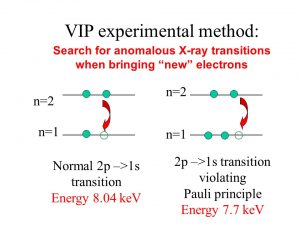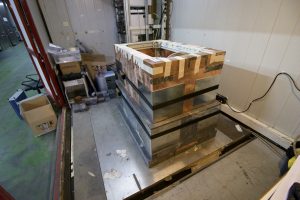VIP (VIolation of the Pauli exclusion principle) in an international collaboration among 10 Institutions from 5 countries which performs an experimental tests of the Pauli Exclusion Principle (PEP) for electrons and investigates the implications of a possible tiny violation in physics and cosmology.
The PEP represents one of the main pillars of modern physics and of our understanding of matter, life and the Universe.
In spite of its enormous success, PEP still generates many debates, deeply rooted in the foundations of Quantum Mechanics, on possible limits of its validity. Feynman wrote 50 years ago that not having found a simple and easy explanation for PEP “probably means that we do not have a complete understanding of the fundamental principle involved”.
In the framework of VIP we perform an experimental search for “impossible atoms transitions”, i.e. atomic transitions forbidden by PEP, by using an apparatus installed and taking data in the underground laboratory of Gran Sasso (Italy).
On the theoretical side we explore theories which could allow the PEP violation, starting from the quon-theory, developed by O. W. Greenberg, where the PEP violation could be related to: violation of CPT, locality, or Lorentz symmetry; existence of extra-dimensions, or the non-commutative spacetime. We are also exploring the PEP violation related to various models of quantum gravity.
 Within VIP, we are also performing other tests on the foundations of quantum mechanics, such as measurement of the spontaneous radiation as a signature of collapse models (GRW) proposed as a solution for the famous measurement problem (related to the Schroedinger cat) in quantum physics and take part in European projects which are testing quantum mechanics, such as the FET-TEQ project: http://www.tequantum.eu/
Within VIP, we are also performing other tests on the foundations of quantum mechanics, such as measurement of the spontaneous radiation as a signature of collapse models (GRW) proposed as a solution for the famous measurement problem (related to the Schroedinger cat) in quantum physics and take part in European projects which are testing quantum mechanics, such as the FET-TEQ project: http://www.tequantum.eu/
VIP method, setup and status:
 We search for PEP violating atomic transitions in Copper and other materials (such as lead) corresponding to electrons arriving of the fundamental 1s level already occupied by two electrons – an explicit violation of PEP.
We search for PEP violating atomic transitions in Copper and other materials (such as lead) corresponding to electrons arriving of the fundamental 1s level already occupied by two electrons – an explicit violation of PEP.

We use radiation detectors such as Silicon Drift Detectors and High Purity Germanium detectors to measure the radiation emitted during the PEP forbidden transitions.
Presently, we are in data taking with our experiment mounted at the underground laboratory of Gran Sasso, LNGS-INFN, where the background generated by cosmic rays is strongly reduced. With additional lead and copper shielding we reduce the environmental background.

We already set very strong limits on the PEP violation probability for electrons (see References) and the data taking will go on for the next 2-3 with the aim to either set the strongest limit on PEP violation by electrons, or will find a violation.
The other quantum mechanics tests, on collapse models, are also going to be performed to improve the actual limit.
A strong collaboration with theoreticians working in quantum foundation is going on, in parallel with the experiment.
Spokesperson
Catalina Curceanu (INFN Laboratori Nazionali di Frascati)
External funding from:
Centro Fermi — Museo Storico della Fisica e Centro Studi e Ricerche “Enrico Fermi”(Open Problems in Quantum Mechanics project)
H2020 FET Project TEQ (grant No.766900)
The Austrian Science Foundation (FWF): grants P25529-N20, project P 30635-N36 and W1252-N27
Foundational Questions Institute (FQXi)
The John Templeton Foundation
REFERENCES:
- High Precision Test of the Pauli Exclusion Principle for Electrons, Condens.Mat. 4 (2019) no.2, 45
- On the Importance of Electron Diffusion in a Bulk-Matter Test of the Pauli Exclusion Principle, Entropy 20 (2018) no.7, 515
- Experimental search for the violation of Pauli Exclusion Principle, Eur.Phys.J. C78 (2018) no.4, 319
- Test of the Pauli Exclusion Principle in the VIP-2 Underground Experiment, Entropy 2017, 19(7), 300
- CSL Collapse Model Mapped with the Spontaneous Radiation, Entropy 2017, 19(7), 319
 INFN-LNF Laboratori Nazionali di Frascati
INFN-LNF Laboratori Nazionali di Frascati
